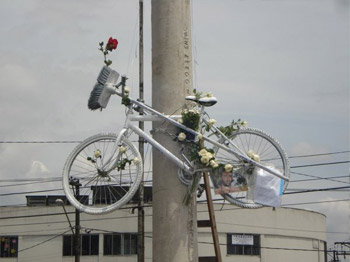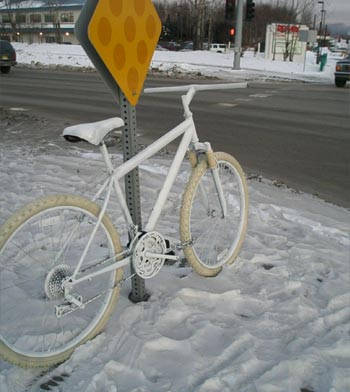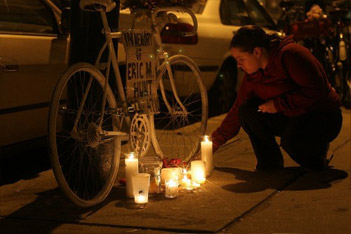
Olivia Rose-Innes A bicycle, painted dead white from handlebars to tires, fixed on a lamp-post high up above the traffic in central Sao Paulo. Another propped against a street sign in Anchorage, Alaska, blending in with the snowfall. One on a New York pavement after dark, gleaming pale in the light of candles arranged beside its stilled wheels.
"Ghost bikes”, often decked with flowers or mementos, make their eerie appearance on roadsides from Singapore to Copenhagen. They mark where cyclists have lost their lives, a poignant reminder to all travellers to take better care.
On 22 May in a parallel campaign, some 200 South African cyclists joined thousands of others internationally in the Ride of Silence, when riders pedal slowly through their cities in a silent, two-wheeled version of the funeral march, to commemorate fallen comrades.
Mean streets
Of the 1.3 million people who die in road traffic accidents every year, about half are cyclists, pedestrians and motorcyclists – called “Vulnerable Road Users (VRUs)” by transport researchers because they lack the partially protective shell a car provides. And as the World Health Organisation's Global Status Report on Road Safety points out, although there has been some progress towards better protection of car occupants, VRUs' needs are still largely ignored.
Debate can get heated and sometimes nasty on who to blame for these deaths - especially between motorists and cyclists, each faction blaming the other for careless and arrogant road use. Research into the issue suggests that drivers are usually (not always, but usually) at fault. An analysis of New York cyclist fatalities in 2000, for instance, found that 75% were caused by motorist traffic violations. Not that fault really matters when motorised and non-motorised collide: the latter always loses.
Detractors of campaigns such as Ghost Bikes and Ride of Silence do make the following unavoidable point: it is surely foolish to take to the 21st century streets on what is essentially a nineteenth-century contraption with laughable safety features. Pedestrians have pavements, and motorbikes command space and attention, but a bicycle in motorised traffic is like a gazelle trying to mingle with a herd of charging rhinos.
Why should this slim, delicate creature think it has any business sharing the same turf as a mass of snorting belligerent bruisers, each one ten times its weight?
Here's the response I like: because cyclists earn their right to that thin strip of tar allowed them, kilometre by risky kilometre, through the humble, vital service they are performing for the planet.
Two wheels good
An invisible giant footprint, an amorphous cloud of gas: environmental impact is hard enough to imagine, never mind calculate. How do we know we're managing to shrink it if we can't really work out how big it was in the first place?
After messing around with unsatisfactory carbon calculators and stymying solar geyser brochures for weeks, not to mention making foolish proclamations on the 'Net that I was headed off down the road to truth, enlightenment and carbon neutrality, I'm going back to basics and starting with the simplest, most obvious and effective way I can make a dent: a fundamental change in personal transport habits.
It's simple, obvious and effective because, firstly, you already have an easy way to measure resources consumed or saved (the odometer on your car or motorbike, and your garage card), and secondly because transport is such a dirty great culprit in fuelling climate change. For the obvious part, see the exhaust pipe of the vehicle in front of you next time you're stuck in the rush hour, and remember (yes, it always comes as a slight surprise to me too) that the same lovely stuff is billowing out of yours.
A recent NASA study has concluded that motorised road transport alone is the biggest net contributer to global warming now, and will continue to be so for the next 40 years. And that's just vehicle emissions; let's not forget the heavy tar and steel tread of the motorised transport giant in its totality: its oil spill calamities and assembly plants and vast tracts of land required for its road networks.
Anyone who is not directly contributing to this mess deserves gratitude, respect and support to swell their numbers on our roads, however stupid you may think they look in their lycra shorts.
If climate change doesn't move you yet, maybe air pollution will: public health studies increasingly indicate that particulate pollutants spewing out of exhaust pipes are especially toxic to the human body – more so even than the sulfates and nitrates the power sector pumps out. Hardly a week goes by without more evidence linking vehicle fumes in our urban areas to heart disease and cancer; it's not only asthma and bronchitis that is of concern in this respect any more.
There are various ways you can do something about this of course, from investing in a Joule, SA's first electric car, to spending more time as one of those other unsung Vulnerable Road Users, the Pedestrians. You're much more likely to make a lasting change if you choose methods that suit your personality and which you can successfully incorporate into your lifestyle. I accept that the change I'm making might not work for everyone, but give it a moment's thought:
A couple of days ago I collected my gentle new beast of burden from the cycle shop where it's been patiently waiting for me, and lead it home, first removing the modest price tag (an amount I'll recoup after a few months of use).
This beautiful machine, which has, indeed, not changed much in 100 years, is still the most energy efficient form of transport ever devised. I'm going to use it for playing on the dirt or spinning alongside the sea some weekends, but mostly I plan to use it for no-nonsense round-town commuting, the health benefits of which, medical statisticians say, outweigh my risks of braving the road.
If you see me and my bike from the other side of the windshield, give us some leeway, even if we waver and wobble a bit: we're saving the world.
- Olivia Rose-Innes, EnviroHealth Editor, Health24, May 2010
Read more:
Clean machine: the multiple benefits of commuter cycling
Fuel-saving tips for four-wheeled addicts
Images sourced from Ghost Bikes
References
Komanoff, C and Smith, MJ. 2000. The Only Good Cyclist: NYC bicycle fatalities - who's responsible?
Unger, N., et al, 2010. Attribution of climate forcing to economic sectors.
World Health Organisation. 2010. Global Status Report of Road Safety




 Publications
Publications
 Partners
Partners













